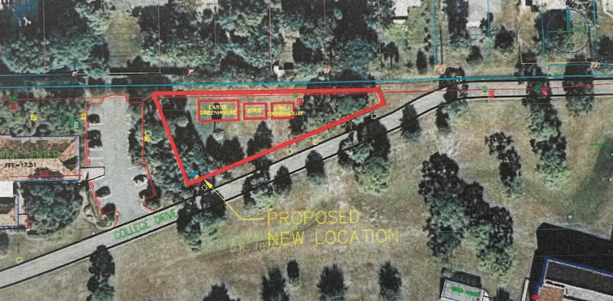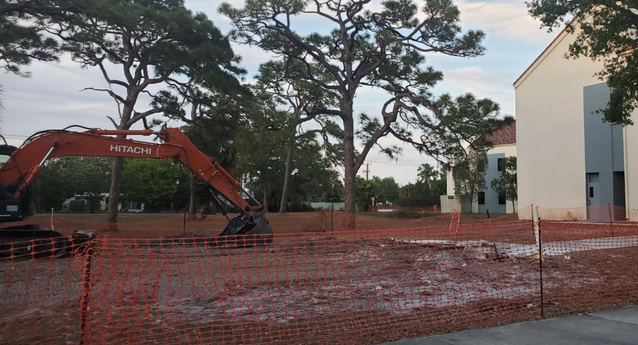Between Mar. 13 and Mar. 24, two greenhouses and their accompanying shed behind the north and west wings of the Heiser Natural Sciences Complex disappeared, confusing the student body. Explanation for the demolition comes after a years-long battle between faculty and contractors who withdrew from repair work, COVID-19-related supply chain issues and two hurricanes that damaged the greenhouses. A week after demolition efforts were first completed, Interim President Richard Corcoran announced via email from Communications and Marketing that various campus improvements will be undertaken in the coming months, including the “replacement of the two greenhouses.”
Corcoran’s plan, as explained on Mar. 15 at a meeting about relocating the greenhouses, is to rebuild the greenhouses east of the Keating Center in the old English style with pointed ceilings and a more aesthetically pleasing appearance.
Professor of Biology Amy Clore spoke with the Catalyst regarding her interactions with Corcoran and his decision to demolish the greenhouses.
“Interim President Corcoran was concerned about the status of the greenhouses and was asking, ‘Do we even need these anymore? Do we use them?’” Clore recounted. “I said [via email], ‘I just want to let you know that we absolutely need the greenhouses, we’ve been waiting.’”
Clore explained how essential these greenhouses are to research done both by students and professors. The greenhouses, where students can learn hands-on, are typically used for classes as well, but the structures’ extended state of disrepair has hindered the possibility of using them to their full potential.
On Mar. 15, Clore was sent an email invitation to an informal meeting in the Keating Center parking lot two hours before the proposed time to talk about shifting the location of the current structures slightly northwest. Present at the meeting were Frisco, Corcoran, former Co-Director of Environmental Studies Jono Miller (‘70) and others.
During the meeting, Corcoran shared his vision for the structures, including the relocation and redesign, with the intent to create a more aesthetic environment on the academic side of campus.
“He wants the English style, which I take to mean pretty peaks,” Clore said. “I know [the current greenhouses] are not aesthetically pleasing. I said that if we’re going to have peaks like that, the heat builds up quite a lot, then that’s an issue for plant fertility.”

Clore stated that she is willing to work with the President and his wishes for an aesthetic appearance. “Wherever the greenhouses end up going, placement of a small three-sided ‘corral’ for our used soil and plant debris, would also help aesthetics.”
Shade was another concern. Miller often volunteers his time to join Landscape and Signage Task Force meetings and offers input on campus initiatives relating to the natural sciences, despite his retirement in 2014.
“I’ve met with the President to convey my main concern regarding the proposed greenhouse location—shade,” Miller told the Catalyst over email. “He understands my concern, but pointed out that the former greenhouse site also had shading issues. I agree. In retrospect, I don’t think the prior site was ideal.”
Miller went on to describe his personal efforts to research the growth and shade provided by the oak trees to the east of the Keating Center, and times of year when the shade would be at its worst.
“LED supplemental illumination is an affordable alternative, but, in general, one should endeavor to site greenhouses in a manner that optimizes natural sunlight,” Miller continued. “I am not aware of all the President’s criteria for siting the new greenhouse/s. I know aesthetics and vistas are important to him. Rather than blessing the proposed east-of-Keating location, I am encouraging the Landscape Task Force to consider other possible locations and then seek guidance from the President.”
This approach was backed up by thesis student and New College Student Alliance (NCSA) Landscape Representative Nick Beck during the Apr. 5 Task Force committee meeting. Beck motioned for an evaluation of two potential locations that could be further considered by the committee at a later date.
“The proposal ended up being a discussion for a while because we didn’t really know how to motion on it,” Beck said in a statement after the committee meeting. “I just figured let the guys who are going to build it take a look.”
Assistant Director Facilities Planning & Construction Itza Frisco then clarified to the committee that nothing has been “set in stone.” Rather, they would meet with an architect and civil engineer on Apr. 7 to further discuss construction and site possibilities. To gain a better understanding of this meeting and the situation at hand, the Catalyst reached out to VP of Finance and Administration Chris Kinsley. Instead, the reply came from Communications and Marketing.
“We do not want to speak for the faculty members, but [we] are not aware of any faculty members expressing discontent with the proposed site,” Communications stated via email. “In fact, at the meeting on Apr. 7, the faculty leads indicated that the proposed new location would work.”
Sites are to be considered and professionals will continue to be consulted, but the April 7 Task Force Committee meeting ended on a thought-provoking note: Frisco made it clear that more information will need to be gathered but “how things move forward is not at the discretion of the committee.”

